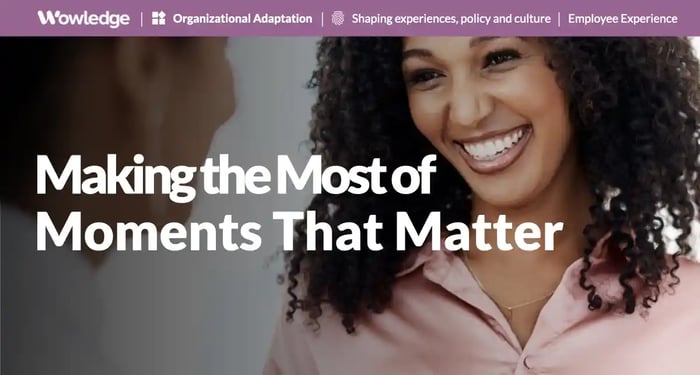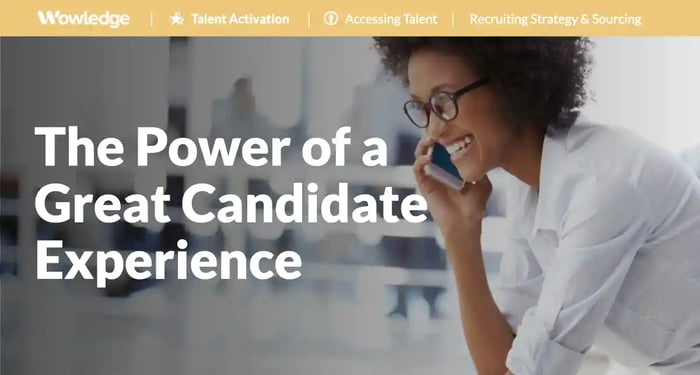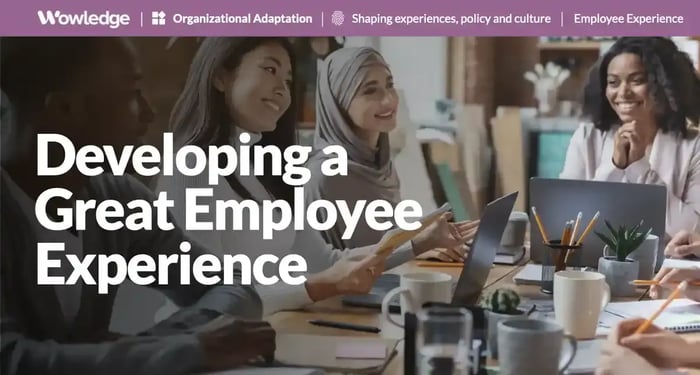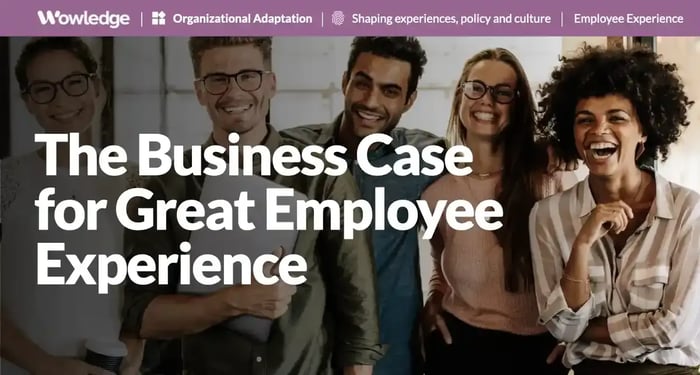Given the continued challenges caused by labor shortages facing organizations across industries, geographies, and sizes, the pressure to attract and retain employees has never been more significant. This brings into greater focus the understanding and meeting of employee and candidate preferences and needs that have elevated employee value proposition (EVP), employee experience (EX), employee engagement, and candidate experience (CX) into the corporate consciousness. The key, however, is to understand the drivers of those experiences, "moments that matter," which are crucial to meeting employees' needs and improving talent outcomes.
Understanding the pivotal events influencing employee perceptions, feelings, attitudes, and workplace perceptions is crucial to establishing a positive and invigorating work environment. These moments that matter are the events that employees remember, appreciate (or regret) for years to come, leaving a lasting impression on their feelings about their work environment, motivation, and employer. These moments shape their future behavior and profoundly impact the company's key metrics, such as engagement, productivity, motivation, and willingness to go above and beyond. This understanding engages us in a commitment to creating a positive work environment.
The goal of generating a clear understanding of these is to enable the focus on continuous improvement efforts on strategically targeted processes and actions (e.g., by people managers) that will more efficiently and effectively drive talent outcomes.
The opportunity for improvement lies in challenging the assumption that HR and managers “know best” what employees want and need and where their pain points exist. For example, Gartner discovered that only 29% of surveyed employees agreed that “HR really understands what people like me need and want.” This presents an opportunity to reevaluate the extent of understanding of employee needs and can lead to more effective talent management strategies.
Defining moments that matter
Moments that matter (MTMs) are the events or occurrences that, when experienced by employees, tend to create the most significant impression on their work perceptions, attitudes, and behaviors. They are the ones that matter the most to employees, as they (fairly or unfairly) communicate the company culture, how much it values them as employees, the extent to which the company or their manager cares about them as people, etc. Large or small, the experiences accumulate over time, and if more positive than negative, they tend to keep workers on an upbeat track of motivation, engagement, and longevity.
Remember that these moments can also create a negative impression if they occur at a significant stage of the employee’s work or personal life. McKinsey, for example, says that while these “moments of truth” can “create a disproportionate uplift in experience,” they can also create employee pain points that need to be addressed.” The negative impact should be treated as the biggest concern, as they can quietly (often unknown to HR and leadership) and unnecessarily create deficits in the most valued talent outcomes.
The concept originates from the marketing/sales concept of the “customer experience,” where "moments of truth" are points in the “customer journey” that determine whether or not a potential customer will buy from a company. Similarly, employee MTMs determine the extent to which they will put forth extra effort, support the company’s mission, goals, and objectives, and help maintain a positive culture of mutual support and innovation.
Types of moments that matter
Moments that matter are critical events, activities, or occurrences that employees experience throughout or at different points in their employment cycle (the “employee journey”) with a given organization. That journey starts with the first interaction with or impression of the company as an employer, producer of products and services, or marketer. It continues throughout the employment cycle, the years of being managed, developed, reviewed, and rewarded, and then through the exit and post-employment relationship timeframes.
Key moments fall into three primary buckets that acknowledge the intertwining nature of employment with an individual’s work and life experiences. These include:
Milestones
These are significant events that are experienced, such as the first day of employment, service anniversaries, promotions, annual performance and merit pay processes, significant work achievements, completion of significant development programs or processes, promotions, and employment termination (retirement, voluntary, or involuntary).
Cyclical events
These are planned and recurring events that are part of the weekly or monthly career flows, including performance check-ins, mentoring/coaching, peer or team recognition, career development discussions, executive acknowledgments, significant administrative tasks or activities (new hire paperwork, annual benefits enrollment, etc.), wellbeing activities (access to, participation in company-sponsored fitness or wellness programs).
Personal
Significant life events occur during one's employment, such as marriage, childbirth, death, illness or injury (self or dependent/significant other), graduation, certification, etc. How the company’s policies and people support and recognize the employee are often crucial moments that create positive or negative impressions.
How one experiences these – the ease or difficulty of engaging in any of those, the challenges and “friction” faced (or not) when encountering the policies, processes, technologies, or people involved – primarily creates the impressions employees take away from them.

Why moments that matter are so important
Moments that matter are critical elements of the employee experience, which drives employee engagement. The body of organizational research on employee experience is substantial and demonstrates that companies that score in the highest percentiles consistently and convincingly outperform their lower-rated peers in:
- Profitability and revenue enhancement
- Employee engagement
- Turnover rates
- Productivity and performance
- Customer satisfaction
- Innovation
- Recruitment and talent acquisition
Furthermore, Gallup’s meta-analysis of hundreds of studies on employee engagement covering over 2.7 million employees worldwide demonstrates the power of a highly engaged workforce. It found that high engagement levels consistently and significantly impact customer loyalty, company profitability, employee productivity, product/service quality, turnover, absenteeism, and well-being.
Focusing on understanding and enhancing the moments that matter allows for more informed and targeted HR investments and drives HR solutions that are directly relevant to employees. It simplifies HR design and redesign efforts from year to year by proactively engaging employees in “fixing” processes, policies, and practices that impact their quality of work. To that end, Gartner reports that 16% of HR functions are working to identify and improve MTMs, and 56% of HR leaders are interested in identifying ‘moments that matter’ for their organization.
Furthermore, 44% of surveyed companies focus their employee experience efforts on key employment lifecycle stages. Those efforts are drilling into employee journeys around five key or “top moments” by measuring onboarding (51% of those companies), performance management (44%), well-being (44%), and recognition (43%).
Specific linkages between employee experience, MTMs, and engagement
As engagement relates to the EX, employee journey, and MTMs, consider Gallup’s “Q12” engagement survey, perhaps the most operationally grounded and statistically proven measure of employee engagement. The Q12 questions can be linked to significant events and occurrences in the employee journey. For example:
Q01. Knowing What's Expected – goal setting, onboarding/Day 1 expectation setting, performance management discussions.
Q02. Materials and Equipment – being properly resourced for the job on day one and on an ongoing basis for tasks, projects, etc.
Q03. Doing What You Do Best – career development planning and discussions, task assignments, performance management process.
Q04. Receiving Recognition – performance check-ins and formal appraisals, post-task feedback, rewards, and recognition.
Q05. Someone Caring at Work – Day 1 meeting people and team engagement activities plus managerial support and coaching during critical work or personal challenges, significant life events, performance check-ins.
Q06. Someone Encouraging Development – manager/mentor skill development opportunity identification, recommendations for assignment of stretch development projects, annual career development planning discussions.
Q07. Opinions Counting at Work – managerial requests for ideas, encouraging input, employee surveys, feedback on workflow improvement suggestions, acknowledgment of contributions to the team, department, or corporate successes.
Q08. Mission/Purpose – managerial communications (onboarding, performance management processes) regarding how individual work provides value to products, services, or mission.
Q09. Commitment to Quality Work – public recognition of individual and team achievements, opportunities to recognize peers’ contributions.
Q10. Best Friend at Work – onboarding greetings, social events, cross-functional projects, employee mobility opportunities.
Q11. Talking About Progress – performance management process, performance check-ins, career development discussions.
Q12. Learning and Growing – access to, availability of, and time away from daily tasks to explore and attend learning and development programming, assignments to project teams, opportunities to apply for new roles.
The opportunities to enhance employee experience and engagement levels are exhaustive. However, the key is to identify those that matter most to each organization, given its unique range of employee types, backgrounds, preferences, and needs. That calls for a structured process that creates a tailored view of who those employees are and what elements of their employment journey significantly impact how they perceive and feel about that employer.

Identifying moments that matter
Understanding the events or occurrences that drive the primary employee perceptions, attitudes, and behaviors related to their employment requires a structured process. It calls for a comprehensive consideration of the employment lifecycle, with key stages and processes that individuals encounter, from career opportunity awareness to their exit (and beyond). The process of “design thinking,” which focuses on assessing and designing work processes based on the end-users' needs, preferences, and skills, is recommended to bring the employee experience into the design and redesign efforts. Moments that matter are identified using this methodology.
The methodology has been developed and promoted in numerous forms, including four fundamental design guidelines: end-user-centric, iterative, collaborative, and flexible/adaptable. Generating MTMs calls for the use of five primary phases (of the six in design thinking):
1. Clarify the strategy and purpose
Create a clear rationale and process to define the reason and desired outcomes from the planned effort. The most common purposes are to 1) align the various employee experiences in support of/consistent with the company culture and 2) reduce/remove their “pain points” currently associated with those critical experiences.
2. Research end-users needs and issues
Collect data (employee surveys, focus groups, exit interviews, system/process/practice use, trouble tickets, complaint logs, etc.) and determine those that appear to represent the most significant opportunities to target for improvement.
3. Identify and develop “personas”
Generate an understanding of crucial employee segments and how each operates and perceives the efficiency and effectiveness of the various processes, practices, policies, and technologies encountered throughout their employment. These should represent the range of participants or users of the processes, such as managers, line employees, and administrative professionals, and may also include specifically targeted groups depending upon the process or practice (e.g., HiPos in the leadership development process, engineers or data scientists in the hiring/onboarding process).
4) Map the journey
Develop a visual map of the significant stages of the employment relationship, such as recruiting and hiring, performance management, learning and development, career progression, exiting the organization, etc. Document the key details or process steps employees encounter, such as in a process map.
5. Identify the moments that matter
These typically emerge from the earlier data collection step from the identified employee pain points. Test those against the data, with discussions centered on the degree of employee dissatisfaction or frustration, and establish testable design assumptions about how employee perceptions and attitudes will improve by fixing one or more of those pain points.
6. Design solutions
Rapidly develop prototypes and test (and subsequently redesign) those in an interactive fashion. This can be as simple as drawing out an improved process flow and presenting it to a group of the targeted employees, followed by a system or format mock-up for their review and, after developing a fully operational prototype, a field test.
Lessons learned on MTM development
Identifying key employment lifecycle stages
Developing the journey map is often as simple as outlining the key steps of the entire employee lifecycle. Still, many organizations miss two key phases – those involved before a candidate applies and then after an employee departs the organization. As a candidate and an alumnus, these are critical elements of the experience. Ignoring the pre-candidate experience risks missing essential employment branding, attraction, and relationship management activities that draw people into the potential for employment. The alumni experience highlights the value of a positive continuing relationship that leads to ex-employee referrals, positive social media reviews, and, as research has proven, an inclination to future purchases of the company’s products and services.
Selecting moments that matter
As discussed, MTMs are events or occurrences throughout the employment journey that are most significant to employees and that they point to as uniquely memorable. As we have seen from research and publications, many involve interpersonal situations (annual performance reviews, manager check-ins, peer or team activities), milestones (offer presentations, first week, annual merit increases, promotions), and how personal situations are handled by the manager or company (childbirth, injury or illness, family death). They often involve formal processes and administrative tasks that are increasingly automated (job application, new hire paperwork, annual benefits enrollment, performance evaluations) and are often frustrating, detailed, or time-consuming. The key is identifying those that run counter to the preferences, biases, and perceptions notated in the Personas, which often clarify that employees want fast and efficient access and administration of their required tasks.
Be prepared to explore the range of HR technologies with which managers and employees interface. Given the nature of organizational technology infrastructures, many company systems are not integrated, causing headaches with the need to enter the same data into multiple systems, one system not reflecting the updated information that may be entered in another, etc. Search capabilities of many HR-related systems are lacking due to a need to tag and cross-tag hundreds, if not thousands, of data fields. For example, knowledge management (KM) systems house valuable insights that new hires, transfers, or promoted employees use to speed their transition to complete competence, often fall short of their primary objective. Learning and development platforms (LMS, LCMS, LX) can cause frustration when content is not regularly, reliably curated, and properly tagged. Introducing AI and machine learning technologies in learning and career systems often takes time for employees to become adept at and may create frustration and confusion over results that fall short of expectations.
Improving interpersonal moments that matter
Finally, be prepared to examine employee feedback and input on purely interpersonal moments closely. Those are often casual, unstructured experiences that can be difficult to codify, track, and create an updated process, system, or practice. Many meaningful moments happen between managers and employees and are rarely documented, captured, and tracked. As a result, designing solutions to under-satisfying performance is a tremendous challenge. Looking back at the elements of Gallup’s Q12 measures, creating a “better mousetrap” that changes the experience in each moment is likely impossible. However, effective improvement solutions can be developed by measuring the outcomes of those interactions over time – through “upward feedback” mechanisms, tracking employee engagement survey data, and reviewing turnover data - manager-by-manager.
Relevant Practices & Tools
Emerging HR Strategy Practices for Engaging Employees and External Partners Now and Into the Future. >
At its most sophisticated level, HR Strategy defines a future centered around optimizing how employees and their needs are managed and how critical external resources... more »
Creating an Employee Experience that Bonds High Performers to the Organization. >
The employee experience constitutes the entire journey an employee takes with the organization. This includes everything from pre-hire to post-exit interactions... more »
Leveraging Design Thinking and Rapid Prototyping for Fast, More Employee-centered, and Responsive Learning and Development. >
Design Thinking is defined as “an iterative process in which we seek to understand the user, challenge assumptions, and redefine problems in an attempt to identify alternative... more »
Using Technology to Deliver Streamlined HR Services and Insights. >
HR Technology has advanced to a level where it is currently capable of offering scalable productivity gains in processing HR transactions, with emerging technologies capable of recognizing... more »
The Internal Environmental Scan Tool: Capture and Categorize Factors Internal to the Company Impacting its Objectives. >
This template provides a structure for identifying key internal topics that should be considered in a formal analysis of the business’s upcoming challenges... more »
About Wowledge
Wowledge is the expert-driven platform for lean teams building strategic HR programs. Members enjoy access to up-to-date best practices, step-by-step guides, tools, templates, and insights to accelerate the design and implementation of all key HR programs and processes.
Since each organization has unique characteristics, needs, and aspirations, Wowledge's practices are developed utilizing an exclusive stage-based approach – from Core to Advanced to Emerging – that reflects distinct levels of sophistication to meet our members where they are.
Build strategic HR programs with refreshingly easy-to-follow best practices.
Get started for FREE! Learn more.










